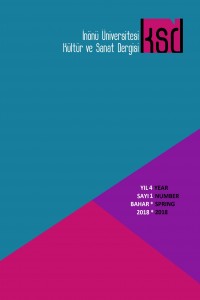LEOPOLD AUER’İN RUS KEMAN EKOLÜNDEKİ YERİ VE ÖNEMİ
Öz
Bu çalışmada öncelikle keman
eğitiminin tarihçesinden kısaca bahsedilmiş daha sonra farklı ülkelerdeki keman
ekolleri incelenmiştir. Bu ekoller arasında özellikle Rus keman ekolü üzerinde
durulmuştur. Rus keman ekolünün önemi, diğer ekollerden farkı ve Leopold
Auer’in Rus keman ekolündeki önemi ve yaptığı eğitimsel katkılardan ayrıntılı
bir şekilde bahsedilmiştir. 18. yy.’dan itibaren Rusya’da keman eğitimi
incelenmiş ve daha sonra 19. yüzyıla gelindiğinde Wieniawski’nin Rusya’daki
etkisinden bahsedilmiştir. 20. Yüzyıla gelindiğinde ise, neredeyse bütün ünlü
virtüözlerin hocası olan Macar kemancı ve eğitimci Leopold Auer’in yaşamı ve
Rusya’da geçen 49 yıl boyunca Rus keman eğitimine yaptığı katkılardan
bahsedilmiştir. Ayrıca icracılığından çok eğitimciliği ve yetiştirdiği virtüöz
öğrencilerle anılan Auer’in eğitimciliğindeki ayırt edici özelliklerden
bahsedilmiştir.
Son bölümde ise 20. yy. Rus keman
pedagojisindeki temel prensipler anlatılmıştır. Bu bölümde özellikle Sovyetler
dönemi Rusya’sında keman okulunun gösterdiği büyük gelişimden ve bu başarının
en temel nedeninin, keman icrası ve keman öğretiminin başta Pavlov’un
çalışmaları olmak üzere, bilimsel esaslara dayandırılarak yeniden
yapılandırılması olduğu vurgulanmıştır. Sovyet keman ekolü ’nün temel aldığı
öğretilerin en önemli unsuru olan “Yüksek Sinirsel Aktivite” açıklanmış ve
Pavlov’un üstünde durduğu bu prensibin keman öğretimine uyarlanırken yapılması
gerekenler anlatılmıştır.
Anahtar Kelimeler
Kaynakça
- 1. Rodrigues, R. (2009). Selected Students of Leopold Auer - A Study in Violin Performance-Practice (Department of Music School of Humanities, unpublished thesis submitted to the University of Birmingham for he degree of “Doctor of Philosophy”) Birmingham. 2. Auer, L. (1921). Violin Playing As I Teach It, New York: Frederick A. Stokes Company Publishers. 3. TDK, Büyük Türkçe Sözlük, (2018). http://tdkterim.gov.tr/bts/. 4. Öztürk, Ö. D. (2012). Sanatta Yeterlik Tezi, Edirne. 5. Lankovsky, M. (2009). The Pedagogy of Yuri Yankelevitch and The Moscow Violin School Including a Translation of Yankelevitch’s Article: ‘’On The Initial Positioning of The Violinist’’ (The City University of New York, Graduate Faculty in Music, “Doctor of Musical Arts”derecesi için sunulan doktora tezi,) New York. 6. (http:/ /leopoldauersociety.com) 22.12.2017. 7. Kovalev-Sluchevsky, K. ‟Хандошкин- Российский Паганини‟ (‟Khandoshkin-Rossiyskiy Paganini‟), http://www.kkovalev.ru/Handoshkin.htm 19.12.2017. 8. “Rus Kemancılık Sanatı” http://blagaya.ru/skripka/history-books/i-yampolskij-handoshkin/ 19.12.2017. 9. Zorlu, B. (2015). Yüksek Lisans Tezi, Ankara.
- 10. Milsom, D. (2003). Theory and Practice in Late Nineteenth-Century Violin Performance, İngiltere. 11. Stowell, R. (2000). Violin Technique and Performance Practice in The Late Eighteenth and Early Nineteenth Centuries, Cambridge University Press. 12. Yağışan, N. ve Aydın, N. (2013). Selçuk Üniversitesi Sosyal Bilimler Enstitüsü Dergisi, Konya.
Öz
In this study, firstly, the history of violin education is mentioned
briefly, then violin schools different countries are examined. Especially the
Russian violin school was emphasized among this schools. The importance of the
Russian violin school, ist difference from the other schools, and the
significance of Leopold Auer for the Russian school and his educational
contributions to it, are discussed in detail. Violin education in Russia is
examined from the 18th century onwards, mentioning Wieniawski and his influence
in Russia in the 19th century. In the 20th century, the life of the Hungarian
violinist and educator Leopold Auer, who was a teacher virtually all famous
virtuosos and the contributions he made to Russian violin education for 49
years in Russia have been mentioned. Additionally, the distinctive traits of
Auer’s education is given, since he is remembered more fort he students he
trained than his performance.
In the conclusion part, basic princibles of the 20th century violin
pedagogy are explained. In this section, the great development of the vioiln
school especially in the Soviet Russia is explained, and as for the main reason
of its success, reconstruction of violin teaching based on scientific
principles expecially that of Pavlov’s work is emphasised. “The Higher Neural
Activity” which is considered to be the most important element of the Soviet
Violin School’s teaching in explained, and the ways of adapting this principles
which Pavlov emphasises to the teaching of violin are described.
Kaynakça
- 1. Rodrigues, R. (2009). Selected Students of Leopold Auer - A Study in Violin Performance-Practice (Department of Music School of Humanities, unpublished thesis submitted to the University of Birmingham for he degree of “Doctor of Philosophy”) Birmingham. 2. Auer, L. (1921). Violin Playing As I Teach It, New York: Frederick A. Stokes Company Publishers. 3. TDK, Büyük Türkçe Sözlük, (2018). http://tdkterim.gov.tr/bts/. 4. Öztürk, Ö. D. (2012). Sanatta Yeterlik Tezi, Edirne. 5. Lankovsky, M. (2009). The Pedagogy of Yuri Yankelevitch and The Moscow Violin School Including a Translation of Yankelevitch’s Article: ‘’On The Initial Positioning of The Violinist’’ (The City University of New York, Graduate Faculty in Music, “Doctor of Musical Arts”derecesi için sunulan doktora tezi,) New York. 6. (http:/ /leopoldauersociety.com) 22.12.2017. 7. Kovalev-Sluchevsky, K. ‟Хандошкин- Российский Паганини‟ (‟Khandoshkin-Rossiyskiy Paganini‟), http://www.kkovalev.ru/Handoshkin.htm 19.12.2017. 8. “Rus Kemancılık Sanatı” http://blagaya.ru/skripka/history-books/i-yampolskij-handoshkin/ 19.12.2017. 9. Zorlu, B. (2015). Yüksek Lisans Tezi, Ankara.
- 10. Milsom, D. (2003). Theory and Practice in Late Nineteenth-Century Violin Performance, İngiltere. 11. Stowell, R. (2000). Violin Technique and Performance Practice in The Late Eighteenth and Early Nineteenth Centuries, Cambridge University Press. 12. Yağışan, N. ve Aydın, N. (2013). Selçuk Üniversitesi Sosyal Bilimler Enstitüsü Dergisi, Konya.
Ayrıntılar
| Birincil Dil | Türkçe |
|---|---|
| Bölüm | Derleme |
| Yazarlar | |
| Yayımlanma Tarihi | 22 Mayıs 2018 |
| Yayımlandığı Sayı | Yıl 2018 Cilt: 4 Sayı: 1 |


